Time in Motion
Assadour Solo Exhibition
12 Sep - 31 Oct 2024
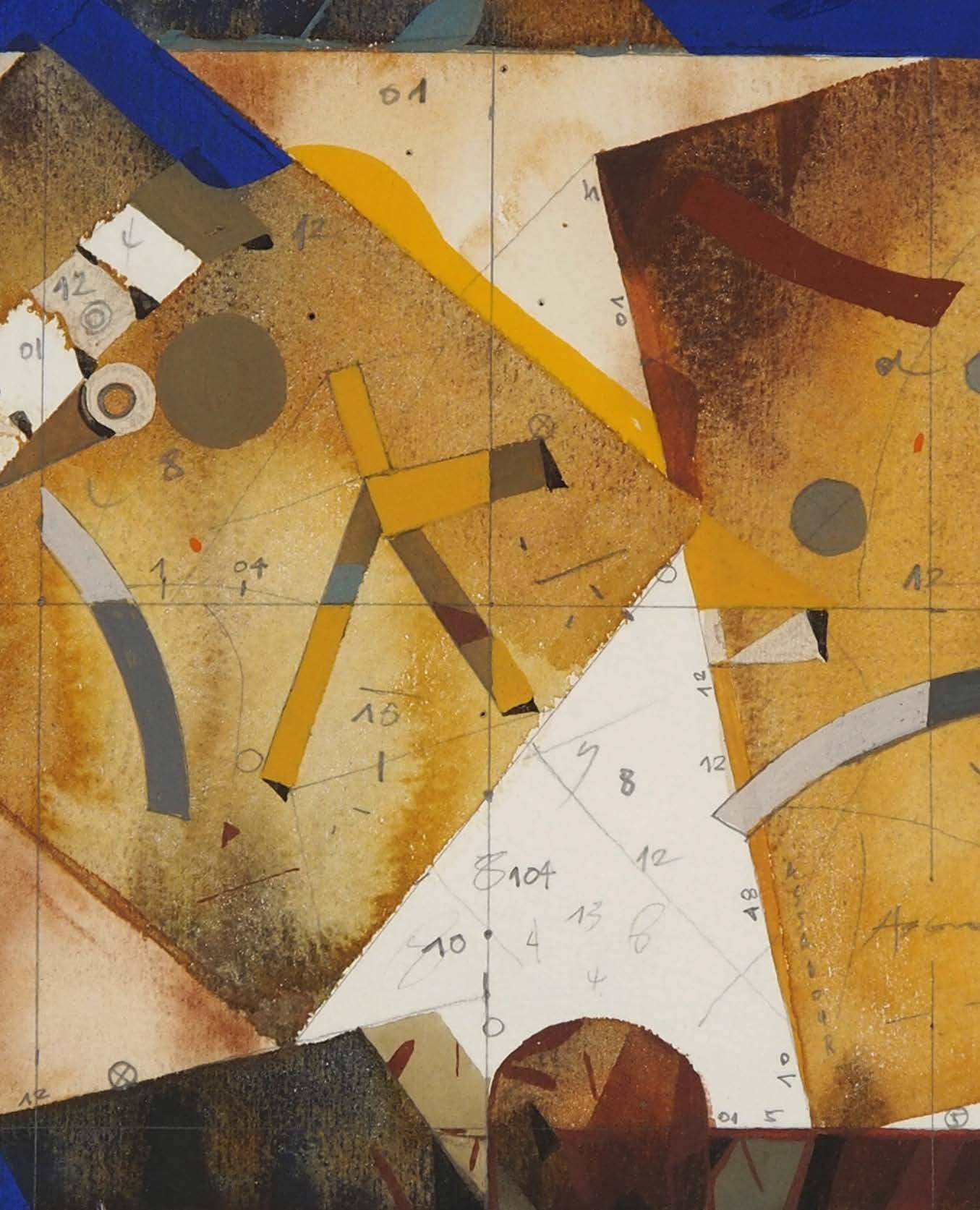



Assadour Solo Exhibition
12 Sep - 31 Oct 2024



Monday - Friday : 9:00 am to 7:00 pm
Saturday by appointment only
Sunday Closed
Janet Rady
+44 (0)7957 284 370 art@janetradyfineart.com
janetradyfineart.com @janetrady
L’ART
info@l-art.uk
Address 37, Thurloe St London SW7 2LQ


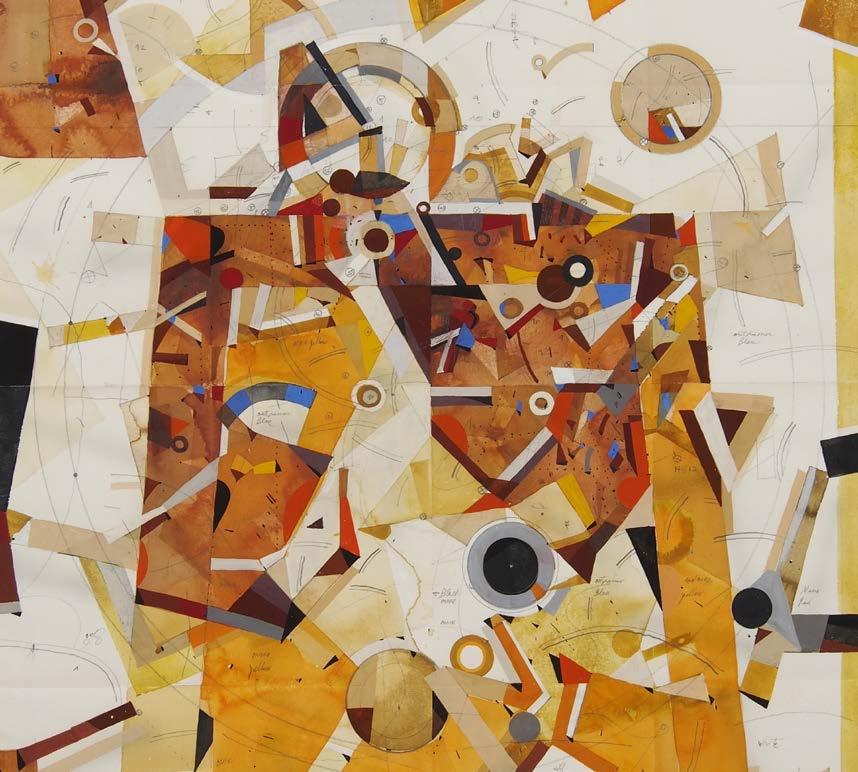
Born in Beirut into a Lebanese-Armenian family in the suburb of Burj Hammoud, Assadour Bezdikian, known as Assadour, took interest in drawing at a very young age. His exceptional talent gave him the chance to pursue his practices in engraving and painting, funded by scholarships supported by the Italian Cultural Centre in Beirut and the Lebanese Ministry of Culture. His first training abroad, debuted at eighteen, was at the Pietro Vannucci Academy in Perugia, where he spent the summer months of 1962 to 1964, followed by a continuous period of study from 1964 to 1970 under the painter and engraver Lucien Coutaud (1904-1977) at the École des Beaux Arts in Paris, where he has been established since.


(B. 1943)

Assadour is recognised for his engravings, despite having also developed a renowned œuvre composed of gouache and watercolour on paper, as well as tempera and oil on canvas. Overall, his works create a realm that flirts with Surrealism, in many ways, much like that of his mentor Coutaud, where extremely complex and detailed imagined landscapes are punctuated by objects dislocated in space, or by other minuscule ones suspended in the air. This results in a world composed of various disarticulations. At times, the objects in his compositions emerge from human heads, emblematic of the nature of Assadour’s complex imagination. His palette is composed of discrete colours that are applied flatly, although he occasionally simulates three dimensional surfaces with a play of light and shadow that creates a delicate sense of translucence.
Time in Motion features works by Assadour (b. 1943), a renowned Lebanese-Armenian artist born in Beirut, who left Lebanon at the age of eighteen to pursue his artistic training with scholarships from the Italian Cultural Centre in Beirut and the Lebanese Ministry of Culture. Initially recognized for his engravings, Assadour has also created an impressive body of work, including gouaches on paper and oils on canvas. This exhibition, held at L’Art in London from September 12 to October 31, is the second show of Assadour’s work in the city, following a successful exhibition at Cromwell Place earlier this year. This time, the event is a collaboration between L’Art, Artscoops, and Janet Rady Fine Art, and showcases over four decades of Assadour’s artistic evolution.
Assadour’s œuvre is emblematic of his exploration of the modern condition, touched by alienation. Drawing inspiration primarily from the Constructivist movement, Assadour’s works utilise geometric abstraction to create rationally produced compositions. The melange of geometric shapes, letters and even numbers create diagrams, revealing a rational system of thinking and design that refers to clockwork and the passage of time.
In the 1980s, Assadour began exploring landscapes filled with geometric shapes illustrating fragmented cities. A decade later, the exploration of such themes persisted with the inclusion of human silhouettes, questioning the construction of identity, our relationship with time and the uprootedness caused by war. Other works from this period also drew influences from East Asian aesthetics, to which he was exposed during frequent stays in the region.

Several decades later, Assadour continued to include abstract human figures in his works. Compared to his previous works from the 1990s, however, these shapes exhibit more defined gradations in colour, creating a pronounced three-dimensional effect.
Assadour’s rich and diverse pieces stand in a league of their own, appealing to different cultures. Characterised by a unique approach to the human condition, the limited number of his pieces contribute to their rarity, making them highly sought after.
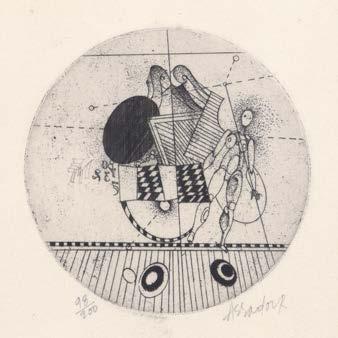
1975 1977

1982 1985 1986
Galerie Vivant, Tokyo, Japan
1979
Alex Monogian Art Center, Beirut, Lebanon
1st New York International Drawing Biennial, Bronx Museum of Art, New York, US
1st European Biennial of Etching, Heidelberg, Germany
New Aspect Gallery, Taipei, Taiwan


2001 2016
Norwegian International Print Biennale, Fredrikstad, Norway
Vico Arte 90, 2nd International
Biennial of Graphic Art, Bamberino Val d’Elsa, Italy
Assadour, Museum Bochum, Germany
Keum San Gallery, Seoul, South Korea
Artgraph Gallery, Nagoya, Japan
2022
Galerie d’Art Contemporain, Chamalières, France
Assadour: Landscape in Motion, Sursock Museum, Beirut, Lebanon
Spuren Und Wege, Osthaus Museum, Hagen, Germany
Primarily recognized for his expertise in prints and engraving, Assadour apprenticed under the esteemed engraver Lucien Coutaud in Paris. The composition of this print is centred around a circular shape, serving as the primary focal point of the work. A human figure, resembling a wooden figurine or mannequin commonly used for anatomical studies, is positioned amidst straight lines suggestive of analytical thought, appearing to be part of a study. Numbers on the left side of the work are mirrored. Additionally, the notation “98/200” likely alludes to the work’s number, part of a series of 200 works. The overall impression conveyed by the artwork suggests humans grappling with the effects of rapid industrialization, which often leads to feelings of alienation.
Untitled I etching on paper 18 x 15 cm edition 98/200 signed.


This monochrome print featuring a capitalized letter A, symbolizing Assadour, is divided into two sections, with the letter A dominating the entire composition. Positioned in the upper part are two female figures, reminiscent of the mannequin depicted in another print, albeit clothed and with minimal detail. This portrayal evokes the recurring motif of humanity amidst machinery, industrialization, progress, and time.
Untitled III etching on paper 20 x 14 cm signed edition 46/60 Executed in 1982.
Executed in tempera on paper in 1982, this work equally stands out from Assadour’s usual body of work. While geometric shapes are present, they are smaller and arranged in a mosaic-like fashion to create a unified shape. Similarly, there is a clear division between two primary sections of the composition. One section, where the mosaic works are densely clustered, appears to depict a cityscape. The character is almost indistinguishable from the background due to their closely matched coloration, as well as being rendered abstractly and depicted from a side angle.
56 x 76 cm
signed
Painted in 1982.


The presence of a protea in a landscape with two characters is indicated by the title. “Protea” refers to a genus of flowering plants native to the Southern Hemisphere, abundant in South Africa. These plants are renowned for their distinctive and variedly sized flowers, often symbolizing diversity, courage, and change. This work incorporates several elements resembling paper cutouts, evoking themes of displacement caused by war and uprootedness. It features male and female figures alongside various domestic objects like a vase and a wine glass. Above them hover machine-like shapes, also rendered in a cut-out fashion. This work stands out from Assadour’s contemporary style, having been produced over three decades ago.
Prot é e, Paysage avec deux Personnages
tempera on paper
78.7 x 58.5 cm signed Painted in 1983.

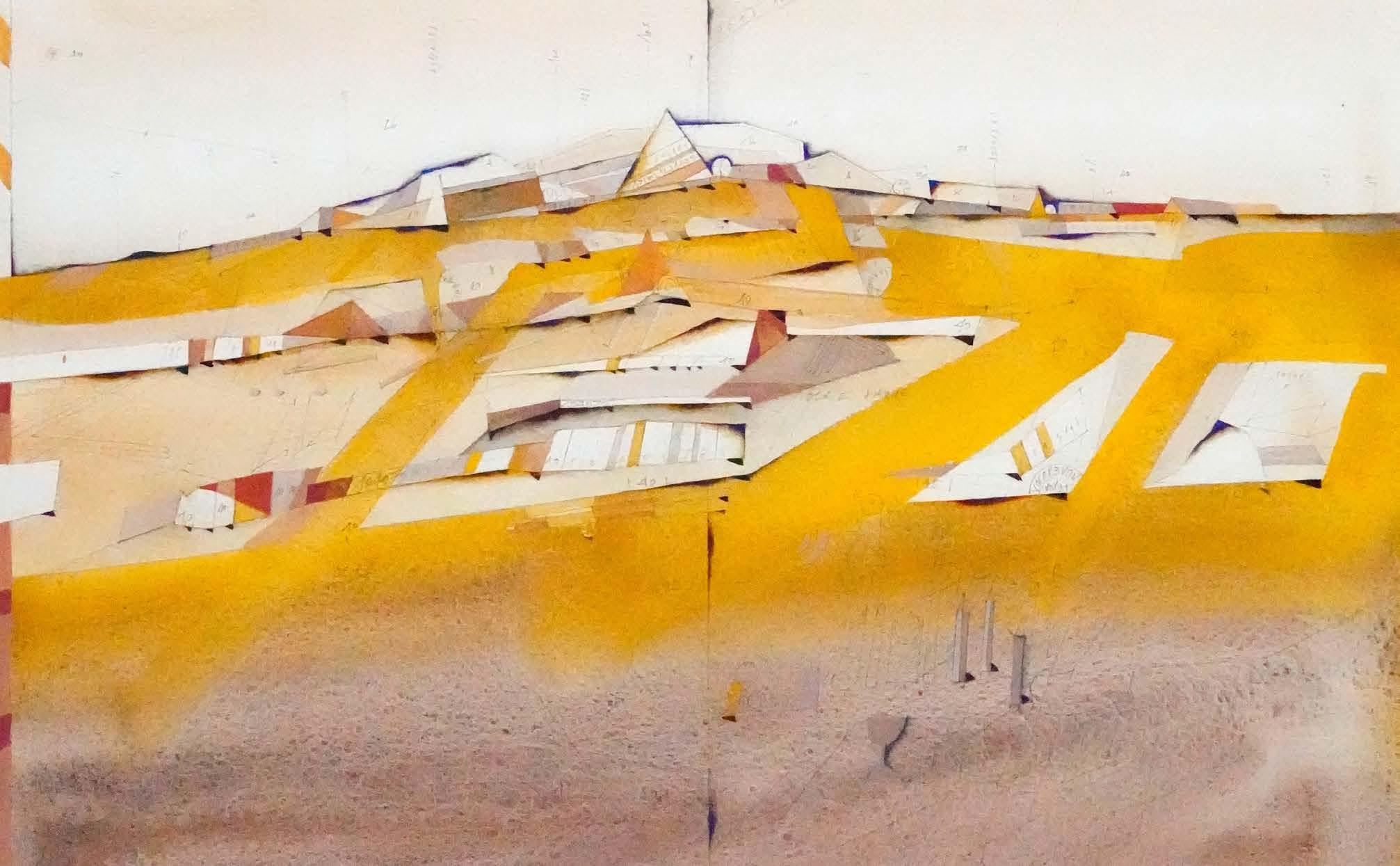
The work’s title implies a focus on a pyramid, yet it comprises numerous triangular and rectangular shapes. Positioned atop a mountain, the pyramid dominates the composition. While yellow dominates the colour scheme, white linear and sharp forms contrast with warm-coloured shapes. The artwork is divided in half, with a distinct horizon line marking its separation.
Pyramid tempera and watercolour on paper
48.3 x 35.6 cm signed Painted in 1983.
This work was produced using tempera and watercolour on paper in 1986. It depicts a city labelled as XVG. Like other urban landscapes featured in Assadour’s body of work, this city appears fragmented. The composition is divided into two distinct sections: a sky and a landscape featuring a mountain. The artwork is densely packed, with minimal negative space aside from the lighter tones representing the sky. The landscape is composed of angular blocks, rendered in Assadour’s typical colour palette of earthy tones such as brown, dark brown, and burgundy. Overall, the work suggests themes of destruction.
Cité No XVG et Objets non Numérotés tempera and watercolour on paper
32 x 24 cm
signed
Painted in 1986.

In this chaotic landscape, shapes are dispersed throughout, accompanied by printed and pencilled letters. Amidst the destruction below, a human figure stands at the top right, gazing down. Despite the chaos, there is a discernible logic revealed through straight lines painted in multiple colours. Within this abstraction, order emerges, showcasing the prevalence of geometry.
No Man’s Land tempera and watercolour on paper
40.6 x 61 cm signed
Painted in 1988.


In this landscape, human male figures intertwine with technology, symbolizing rebuilding. Chaos reigns amidst meticulously painted elements and details.
A circle, likely to have been drawn with a compass, adds a focal point. Pencil-jotted numbers accompany several blocks of warm colours, characteristic of Assadour’s palette.
Golden Landscape tempera and gouache on paper
33.7 x 24 cm signed Painted in 1993.
In Thailand, Songkla is a city where Assadour spent extended periods, part of his time spent in various East Asian locations. This work, as indicated by its title, serves as a reference to his stay there. It features abundant geometrical shapes, yet its composition appears bifurcated. The upper part evokes the sky, while the lower part suggests the land, where human-like forms populate the right side.
Suite Songkla I tempera and watercolour on paper
25.5 x 17.5 cm signed Painted in 1994.

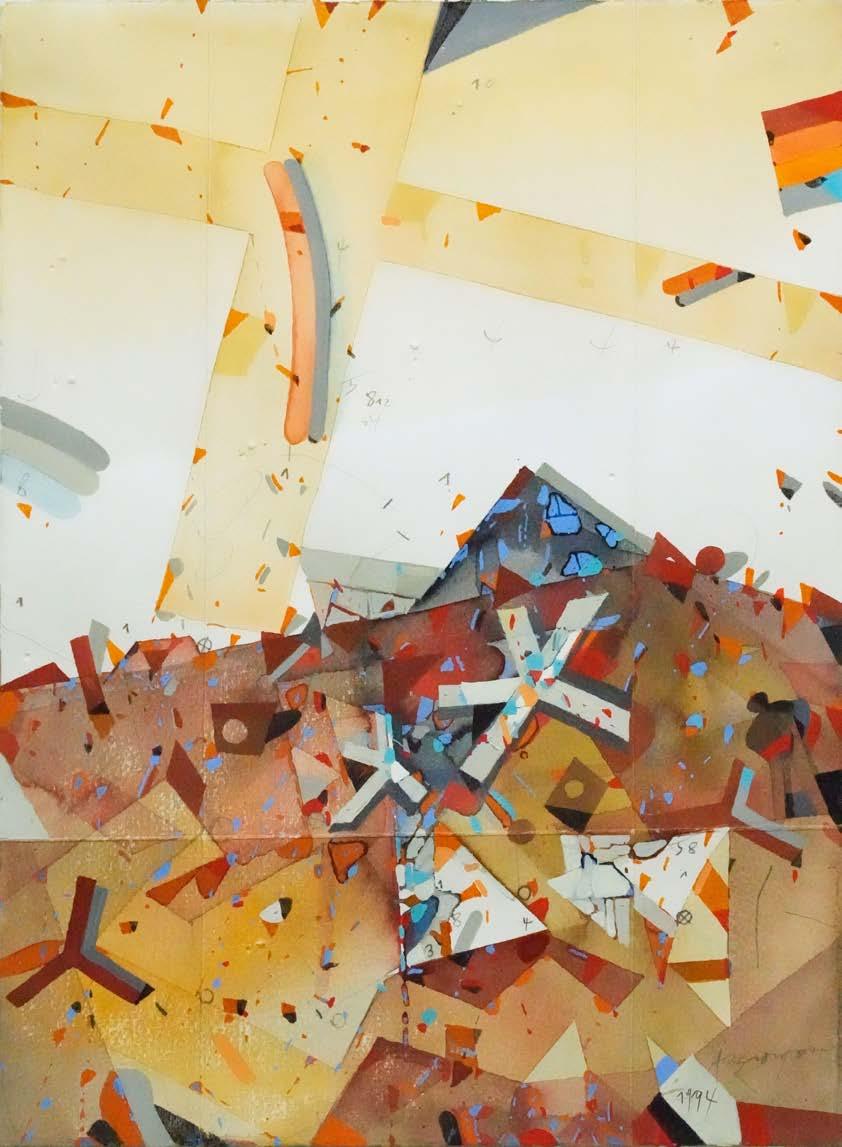
Emblematic of Assadour’s inclination, this work reflects his penchant for disassembling landscapes, infusing them with utter chaos. The small shapes, crafted from straight lines and adorned with hues of red, blue, teal, and orange, ignite a kinetic energy, instigating disorder within the scene. Here, a human figure confronts a triangle in the landscape, symbolizing a mountain.
Paysage avec un Personnage à Droite I tempera and gouache on paper
38 x 27 cm signed
Painted in 1994.
Two primary blocks dominate this work produced in 1995, set in Matera, a city in southern Italy: one rectangular and the other a fusion of circular and geometric shapes. Human forms and silhouettes hover in uncertainty within the composition. Warm colours, likely reminiscent of Assadour’s experiences in Italy, permeate the artwork. Carefully outlined shapes exhibit geometric abstraction, characteristic of his 1990s style. Translucence in the colours is achieved through watercolour, and coloured lines frame the paper’s contours.
Suite Matera I gouache and watercolour on paper
18 x 26 cm
Painted in 1995.

Warm colours prevail in this landscape, with stars strewn throughout the work. Delicately painted with watercolour, even numbers provide a nuanced touch. Depth is achieved through translucence in the brushstrokes. Colour blocks are clearly defined, meticulously divided on the paper’s surface. Arrows, pointing in multiple directions, contribute to the dynamic yet logical nature of the composition.
Paysage avec deux Personnages à Droite tempera and watercolour on paper 26 x 36 cm signed
Painted in 1996.


Part of the series set in Matera, the artwork features prominent large circular shapes painted in various colours, serving as its focal point. Like many of Assadour’s other works, a clear demarcation exists between two primary sections: one representing the sky or cosmos, and the other symbolizing the earthly landscape. Disorder pervades the lower portion, depicting the landscape cluttered with numerous squares, lines, and dark-coloured geometric shapes. A star, positioned in the middle left, further alludes to the cosmos. Additionally, numbers are pencilled onto the canvas, illustrating an order within chaos.

The portrayal depicts the small village of Manera situated in Italy’s Piedmont region. Watercolour and gouache adorn a paper affixed to the canvas. Central to the artwork is a circle seamlessly integrated into a trapezoid shape. Clearly defined blocks of colour enhance the composition. Throughout the painting, numbers are inscribed in pencil, predominantly even. Additionally, human figures are incorporated, with one on the right resembling a shadow.
Suite Matera II
watercolour and gouache on paper mounted on board
18 x 25.4 cm signed
Painted in 1997.

Assadour’s artistic phase in Italy involved the incorporation of warm hues like reds, oranges, and yellows. Positioned centrally within the artwork is a trapezoid, serving as the focal point. Human figures populate the disarrayed scene, comprised of cylindrical blocks. Throughout the work, a star—a cosmological symbol—is meticulously sketched in pencil, while the letter A in printed form, likely standing for Assadour, occupies the upper-left corner.
Suite Matera III
watercolour and gouache on paper mounted on board 18 x 25.4 cm signed
Painted in 1998.
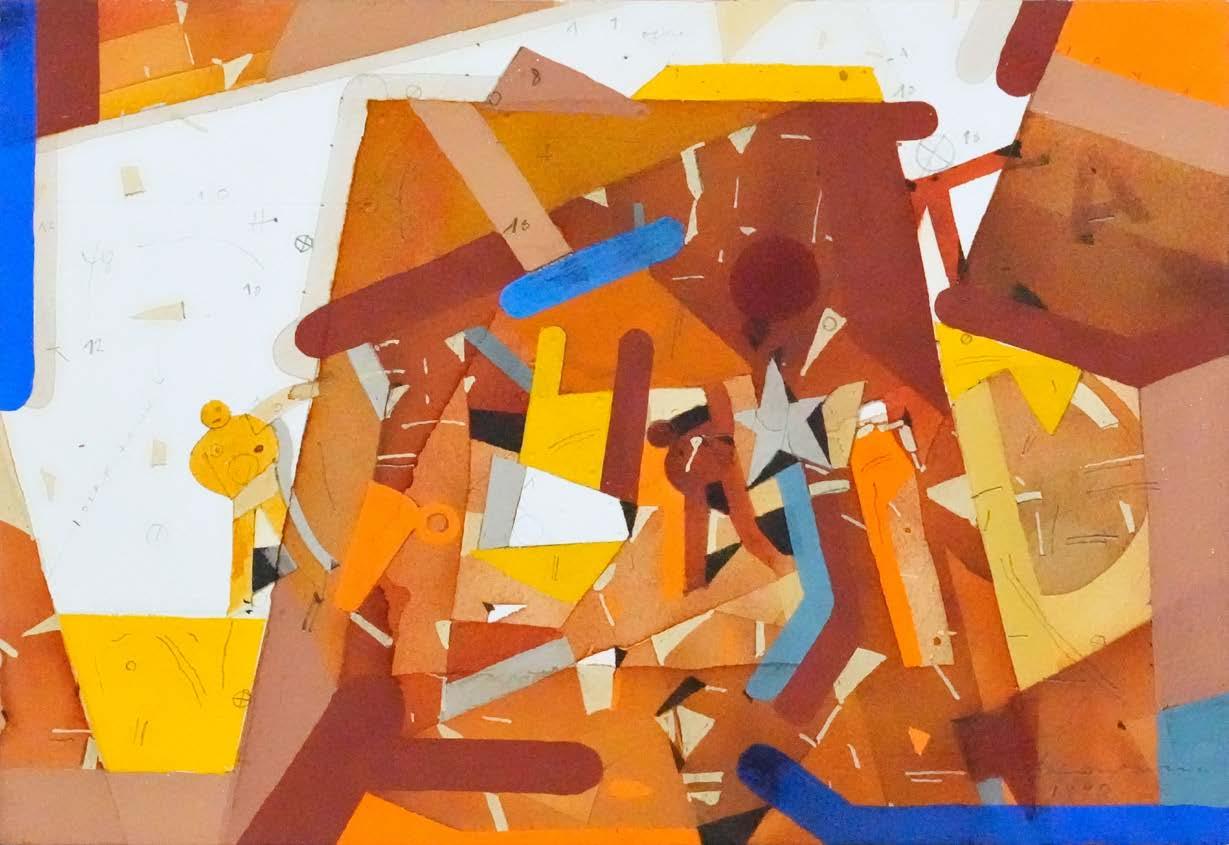
A significant portion of the composition created using tempera and watercolour on paper is dominated by a circle. It serves as a prime example of Assadour’s geometrical abstraction and his ability to find order within disorder. While predominantly abstract, the shapes are well-contained, along with their respective colours. The lines are straight, and the elements are meticulously delineated. This adherence to order is reminiscent of Suprematism, an early twentieth-century art movement characterized by basic geometric forms painted in a limited range of colours, a term coined by Kazimir Malevich. Assadour adds his own personal touch by including pencilled numbers and the names of colours such as yellow and blue. The character referenced in the title of the work is depicted abstractly, devoid of a discernible identity.
Paysage avec un Personnage à Droite II
tempera and watercolour on paper
79 x 53.3 cm signed Painted in 1998.


Two characters find themselves within a landscape, as indicated by the work’s title in French. The scene features two arcades containing various shapes, some linear and others circular, alongside the number two. Notably, two figures are painted in light brown. Despite the overall geometric and chaotic composition, the arrangement of shapes imparts a sense of order within the chaos, evoking the style reminiscent of Kazimir Malevich, a Russian avant-garde artist of the twentieth century.

Deux Personnages dans un Paysage gouache and watercolour on paper
28 x 38 cm signed
Painted in 2000.
Assadour, through oil, facilitated the accentuation of shapes’ three-dimensional aspect in his paintings, a process more challenging with watercolour, gouache, and tempera. Breaking away from his typical warm palette, Assadour inserted darker colours onto this work. A mechanical aspect is conveyed by the grey hues, implying that the depicted surfaces are metallic. Geometric abstraction remains predominant, emphasizing the connection of our world to everyday technology, industrialization, and machinery.



